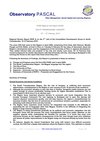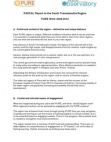South Transdanubian Region, Hungary
So far as the public administration perspective is concerned, the South Transdanubian Region (a NUTS 2 level region) consists in the administrative sense of Baranya, Somogy and Tolna counties (NUTS 3 level), which are further divided into a total of 24 micro-regions (NUTS 4 level). The centres of the counties, also the major cities (of county rank) of South Transdanubia are Pécs, Kaposvár and Szekszárd. The settlement structure of the region is unfavourable, characterised by an underdeveloped urban network, on the one hand, and the dominance of micro- and small settlements, on the other.
South Transdanubian Region, amongst each of the other Hungarian statistical regions, has been created for development and planning purposes and has no legitimate basis for administrative functions. The act on regional development and physical planning made in 1996 created seven Hungarian regions and the seven regional development councils representing them.
The region of South Transdanubia covers the south-western part of Hungary, a territory bordered by the Danube and Drava Rivers and the Lake Balaton (the latter making a natural state border to Croatia). The region has a territory of 14,169 km˛-s and was home to 977 thousands inhabitants in early 2005; the population density of 70 people/km˛ makes South Transdanubia the most sparsely populated area of Hungary. The regional centre is Pécs, a city with 160 thousand inhabitants that concentrates a major part of the economic and cultural life of the region.
The population of the region of South Transdanubia was 977 000 inhabitants in 2005. Similarly to the national tendencies, the population of the region is decreasing and ageing. The three most typical national or ethnic minorities of South Transdanubia are the German, the Croat and the Gipsy minority. Of all Germans living in Hungary, 30% live in South Transdanubia, the same figure for the Croats and Gipsies are over a third and 13%, respectively. The highest
share of ethnic minority population can be found in the micro-region of Mohács (26%) and Pécsvárad (23%), primarily due to the presence of the German ethnic minority.
 Printer-friendly version
Printer-friendly version- 216 reads











